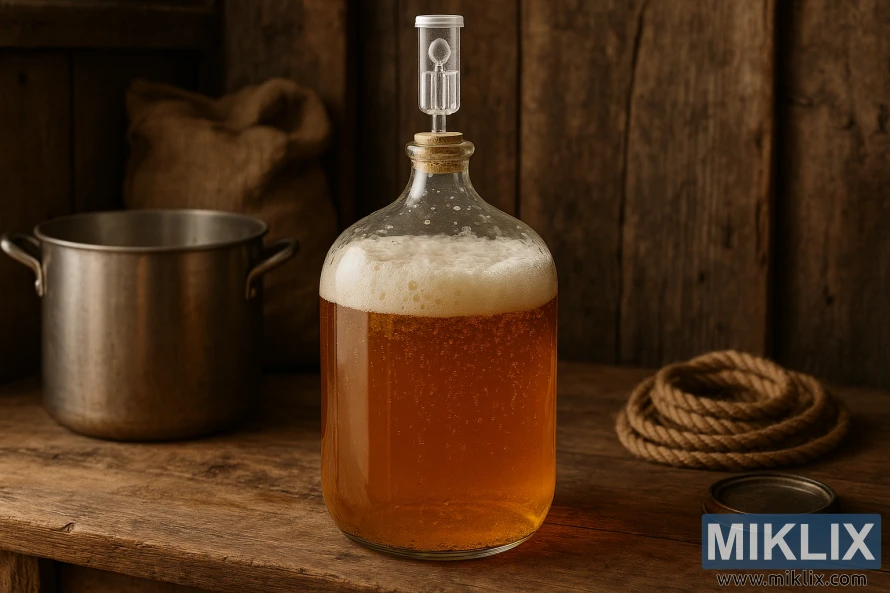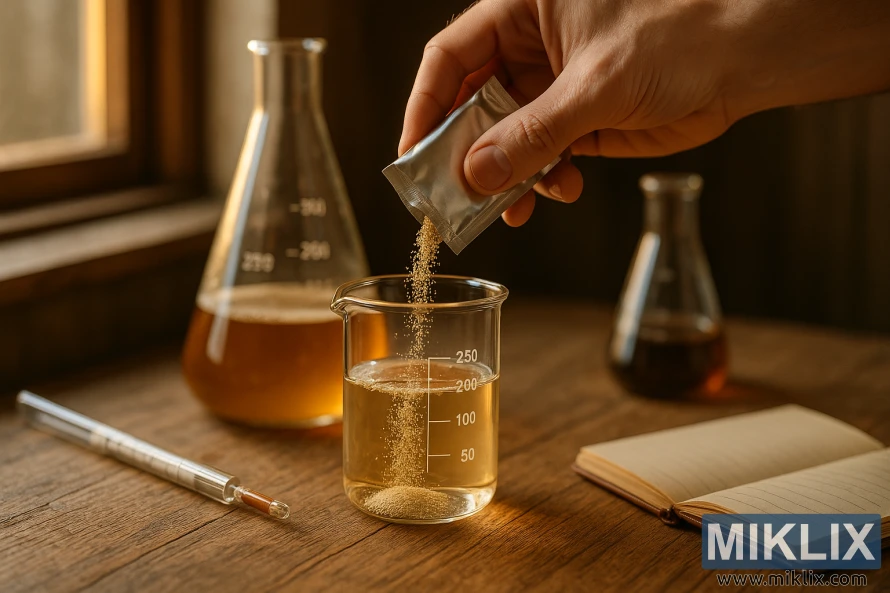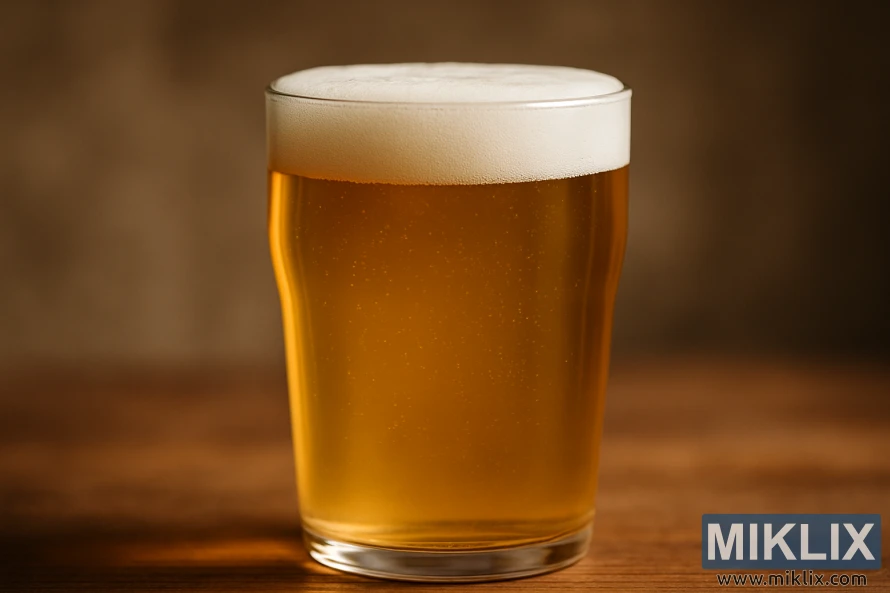Fermenting Beer with Mangrove Jack's M54 Californian Lager Yeast
Published: September 25, 2025 at 7:47:04 PM UTC
This introduction outlines what homebrewers can expect when fermenting with Mangrove Jack's M54 Californian Lager Yeast. M54 is marketed as a lager strain that performs well at ambient ale temperatures. It offers high attenuation and strong flocculation. This makes it attractive for brewers who want clean lager character without strict cold fermentation. Real user reports help set realistic expectations. One brewer noted a final gravity near 1.012 and perceived excess sweetness and muted hop bitterness. They described the result as thin and lacking balance. This highlights how recipe formulation, mash efficiency, and hopping must pair with the yeast’s profile when using M54.

Overall, an M54 yeast review often praises its ability to ferment warm and finish clean. This makes it suitable for California Common and other lagers brewed at 64–68°F. This section prepares you to dive deeper into strain profile, temperature guidance, pitching methods, and troubleshooting when fermenting with M54 as your homebrew lager yeast.
Key Takeaways
- Mangrove Jack's M54 Californian Lager Yeast ferments clean at ale temperatures (18–20°C / 64–68°F).
- M54 shows high attenuation and flocculation, helping achieve clear beer without extended lagering.
- Some batches report a slightly high final gravity (around 1.012) and subdued hop bitterness if recipe balance is off.
- Proper mash efficiency and hop dosage matter when fermenting with M54 to avoid perceived sweetness.
- M54 is well suited for California Common and ambient-temperature lagers for homebrewers seeking simpler lagering.
Introduction to Mangrove Jack's M54 Californian Lager Yeast
This introduction to M54 yeast covers the basics for brewers interested in a versatile lager strain. Mangrove Jack's M54 is a Californian lager yeast. It combines the crisp, clean qualities of lagers with the convenience of ale-temperature fermentation.
So, what is M54 in simple terms? It's a strain designed for those who desire lager clarity without the need for cold conditioning. It's perfect for California Common and other lagers fermented at ale temperatures.
Mangrove Jack's lager yeast intro emphasizes its ease of use and broad tolerance. It's important for brewers to remember that results can vary based on pitch rate, wort gravity, and temperature control. For instance, one brewer expected a drier finish but ended up with a higher final gravity and perceived sweetness. This shows how fermentation can alter the balance and how hops are perceived.
- Typical use cases: California Common, amber lagers, and hybrid styles.
- Performance notes: clean ester profile when kept moderate, possible residual sweetness if fermentation stalls.
- Practical takeaway: monitor fermentation and adjust pitching or temperature to hit target final gravity.
A Californian lager yeast overview sets the stage. M54 offers a middle ground for homebrewers. It allows for lager character without the need for long lagering times or precise refrigeration.
Profile and Characteristics of the Yeast Strain
Mangrove Jack's M54 is known for its high attenuation, meaning it consumes a significant portion of wort sugars. This results in a drier beer. Brewers must closely monitor the target gravity to avoid altering the beer's sweetness and hop balance.
The yeast exhibits strong flocculation, aiding in quick beer clarity post-fermentation. This characteristic minimizes the need for prolonged cold conditioning, speeding up the process for small batches. It also facilitates faster racking to secondary or packaging stages.
M54's flavor profile is characterized by its clean and lager-like nature, even when fermented at warmer temperatures. This makes it ideal for California Common and other hybrid styles, where crispness is key.
Monitoring fermentation is essential. If the final gravity is higher than expected, the beer might retain sweetness and have subdued hop flavors. Regularly tracking gravity readings allows for adjustments to mash profiles or yeast pitch rates to achieve the desired balance.
In summary, M54 provides consistent attenuation and flocculation with a neutral flavor contribution. It's an excellent choice for brewers aiming for a clean lager yeast that can handle a range of fermentation conditions.

Recommended Fermentation Temperatures and Practices
Mangrove Jack's M54 strikes a perfect balance between lager characteristics and homebrewer ease. The recommended fermentation range of 18-20°C ensures clean ester profiles. This helps maintain the crispness typical of Californian lager yeast.
The ability to ferment lager at ale temperatures is a significant benefit. Running a gentle 18–20°C schedule in a spare room or insulated chamber is feasible without a full refrigeration setup. This makes ambient lager fermentation more accessible to hobbyists.
During active fermentation, it's essential to keep temperature swings minimal. Sudden temperature increases can elevate esters and fusel alcohols. On the other hand, drops can slow down attenuation. If fermentation finishes early or the final gravity is higher than expected, check the temperature consistency and wort composition first.
- Pitch to a healthy cell count and maintain 18–20°C for primary fermentation.
- Allow a short diacetyl rest toward the end if needed, then cool slightly before packaging.
- Expect shorter conditioning than traditional lagers; extended months-long lagering is usually unnecessary.
When fermenting M54 at 18-20°C, focus on monitoring gravity and flavor over time. This yeast handles ambient lager fermentation well. Yet, real-world outcomes can vary based on mash profile, oxygenation, and pitch rate.
For brewers transitioning from ale strains, note that fermenting lager at ale temperatures with M54 simplifies the process. It reduces the need for complex temperature control. This makes it easier to produce clean, drinkable lagers in a typical homebrew environment.
Pitching and Usage Instructions for Homebrewers
Mangrove Jack's M54 is a dry ale-style lager yeast, perfect for Californian lager profiles. Before starting, read the packet directions. The manufacturer advises sprinkling yeast M54 directly onto up to 23 L (6 US gal) of wort without a starter for typical gravity beers.
Follow these points for repeatable results when you learn how to pitch M54.
- Temperature: chill the wort to the recommended fermentation range for M54 before pitching to avoid thermal stress.
- Oxygenation: provide adequate oxygen at pitching so yeast can build biomass and ferment cleanly.
- Nutrients: add yeast nutrient for higher gravity or adjunct-rich worts to support healthy attenuation.
Consider the pitch rate M54 recommendations for your batch size. For standard-strength 5–6 US gal batches, a single sachet used as directed will usually be enough. If you plan a high-gravity lager or want extra assurance of a vigorous start, prepare a starter or use multiple sachets to increase cell count.
Here are practical M54 usage instructions for different scenarios.
- Low- to medium-gravity wort (up to 1.050): sprinkle yeast M54 directly onto cooled wort, gently stir to distribute, then seal and monitor.
- High-gravity wort (above 1.050) or large batches: make a starter or pitch two sachets to raise effective pitch rate M54 and reduce risk of stuck fermentation.
- When rehydrating: if you prefer rehydrating, follow standard dry yeast rehydration practices and then pitch to the wort.
Monitor fermentation activity closely during the first 48 hours. If signs of sluggish start appear, check temperature, oxygen, and nutrient levels before taking corrective action. Brewers report M54 gives clean lager character when used with correct oxygenation and a thoughtful approach to pitch rate.

Recipe Ideas Best Suited to M54
Mangrove Jack's M54 excels in malt-forward, clean beers. It's perfect for recipes aiming for a crisp, dry finish. Ferment at warmer, ambient temperatures for the best results.
Start with a classic California Common recipe. This style emphasizes toasty Munich or Vienna malts and clean attenuation. It's a true steam beer when hopped moderately with Northern Brewer or Cascade.
For lighter lagers, choose pilsner or light Munich malts and limit specialty grains. Simple malt character keeps the profile crisp. Subtle hop notes can then shine through.
- Amber lager: use Caramel 60 for color and a higher mash temperature for a fuller body. Monitor attenuation to avoid excess sweetness.
- Light pilsner: keep the grist simple, mash lower, and dry-hop minimally for a clean, bright finish.
- California Common: mash at 152°F, target a lower final gravity, and balance with moderate hopping.
When brewing lagers with M54, ambient fermentation is a good choice. Design the grain bill and hopping to match the yeast's high attenuation. This ensures the beer stays balanced and not cloying.
If you prefer a stronger hop presence, adjust the recipe to lower the final gravity or increase bitterness. Track gravity closely during fermentation. This confirms the beer reaches the intended dryness and hop balance.
Homebrewers looking for variety will find M54 suitable for amber lagers, light pilsners, and California Common styles. Focus on simple, well-calibrated recipes for the best results with M54.
Fermentation Timeline and Expected Final Gravity
Mangrove Jack's M54 shows activity within 12–48 hours at recommended temperatures. A standard M54 fermentation timeline for ales fermented warm or lagers fermented at the higher end of the lager range will include strong primary attenuation during the first week.
Monitor gravity daily with a hydrometer or refractometer. Tracking helps catch stalls and brings clarity on M54 final gravity as fermentation slows. In many batches, expect most gravity drop to occur by day 5–7.
User reports note variation between target and measured values. One brewer targeted an expected FG M54 near 1.010 but finished around 1.012, which left perceptible sweetness. This outcome highlights the importance of controlling oxygenation, nutrient levels, and pitch rate to reach target FG.
Recipe composition affects the final number. High dextrin malts, mash temperature, and adjuncts push the expected FG M54 upward. High attenuation by M54 tends to yield lower FG compared with low-attenuating strains, but exact lager FG with M54 depends on wort fermentability.
- Step 1: Start gravity check after 24 hours to confirm activity.
- Step 2: Read hydrometer on days 3–5 to map the M54 fermentation timeline.
- Step 3: Confirm the final reading with two identical measures 48 hours apart before packaging to verify M54 final gravity.
For lager batches, plan for a clean finish without long cold conditioning when fermenting around 18–20°C. If lager FG with M54 ends higher than intended, consider re-pitching active yeast, warming briefly to restart fermentation, or adjusting future mash schedules to lower the target FG.
Avoiding and Troubleshooting Off-Flavors
Mangrove Jack's M54 is designed to minimize common warm-fermentation issues when used within its recommended 18–20°C range. This reduces the likelihood of off-flavors and eliminates the need for extensive lagering to remove esters.
Despite this, some brewers encounter overly sweet beer or a lack of hop presence. These issues often stem from underattenuation or premature fermentation cessation. To address this, it's essential to verify the pitch rate and oxygenation levels. For high-gravity worts, consider using a starter or an additional sachet. Adequate aeration before pitching is also critical to ensure yeast health.
- Confirm mash temperature and wort fermentability. A high mash rest can elevate final gravity, leading to sweet beer.
- Monitor fermentation temperature. Temperature fluctuations can stress yeast, affecting attenuation.
- Measure gravity twice over 24 hours to confirm fermentation completion.
If the final gravity remains above target, repitching with active, healthy yeast may be necessary to restart attenuation. For extremely sweet beer where yeast cannot lower the final gravity further, enzymes like amyloglucosidase can help break down dextrins, fixing the sweetness issue.
Some brewers employ a short diacetyl rest to address buttery notes. Raising the temperature slightly towards the end of fermentation allows yeast to reduce diacetyl levels. If issues persist, blending with a drier batch or cautious bottle conditioning may be necessary.
To effectively troubleshoot M54, maintain detailed records of pitch rate, oxygen levels, mash profile, and temperatures. These records facilitate quick identification of the root cause. Common solutions include improving oxygenation, adjusting mash temperatures, and ensuring proper yeast health at pitching.
When troubleshooting M54, follow a structured approach. First, confirm gravity targets and verify yeast viability. Next, address oxygen and mash settings. If necessary, consider enzyme treatment or repitching. This methodical approach maximizes the chances of resolving sweetness and restoring balance to the beer.
Conditioning and Lagering Expectations with M54
Mangrove Jack's M54 offers a clean, crisp finish with strong flocculation, speeding up settling. Homebrewers often find that M54 conditioning is quicker than traditional lager strains. With proper cold-crash and racking, you can achieve clearer beer soon after primary fermentation.
The typical M54 lagering time is shorter than classic lager schedules. A brief cold-conditioning of one to two weeks is often sufficient for pale lagers and Californian-style beers. This shorter timeframe allows brewers to package their beer sooner while maintaining the yeast's clean profile.
If your beer tastes sweeter than desired at packaging, check the final gravity before bottling. Allow additional time for conditioning until the gravity stabilizes. Extended cold contact enhances perceived dryness and highlights hop character when needed.
For many recipes, skipping extended lagering with M54 is reasonable. Yet, gravity drift or haze might benefit from a bit more time in the keg or bottle. A small increase in time can enhance M54 clarity without obscuring its bright, neutral character.
- Expect faster clearing thanks to high flocculation.
- Use short cold conditioning—1–2 weeks—for typical lagers.
- Hold for extra conditioning only if gravity or taste indicates it.

Comparing M54 to Other Mangrove Jack's and Commercial Strains
Brewers comparing M54 yeast to other Mangrove Jack's strains will notice a distinct design difference. M54 is a lager strain engineered to thrive in warmer fermentation conditions. It aims for clean, low-ester profiles, unlike many Mangrove Jack's ale strains that highlight fruity esters and quicker fermentation.
When comparing M54 yeast to traditional lager strains from commercial labs, focus on attenuation and flocculation. M54 exhibits high attenuation and strong flocculation, aiding in faster clarification. In contrast, classic lager strains often require colder temperatures and longer lagering to achieve similar clarity and flavor neutrality.
Practical lager yeast comparison is key for recipe selection. At ale-range temperatures, some strains may produce noticeable esters or underattenuate. M54 aims for minimal off-flavors at these temperatures, though results can vary between batches. Monitoring final gravity is essential to confirm how your system handles the strain.
- Performance: M54 balances lager-like cleanliness with ale-temperature flexibility.
- Flavor: Expect fewer esters than many ale strains but not the exact cool-fermented character of traditional lagers.
- Usage: Use M54 when you need lager results without strict cold conditioning.
To evaluate M54 vs other Mangrove Jack's options, conduct side-by-side small batches. Track attenuation, fermentation time, and sensory differences. This hands-on comparison will show how lager yeast comparison plays out in your brewery or garage setup.
User Experiences and Reported Results
Homebrewers have mixed opinions on M54 user reviews. Many praise its clean lager character and reliable attenuation. This is true when fermentation is kept between 18–20°C with proper oxygenation.
One homebrewer reported an overly sweet beer with a final gravity near 1.012, despite aiming for 1.010. They also noted a lack of hop presence and described the flavor as "roasted soda water." This highlights how yeast performance can vary based on pitch rate, wort composition, and fermentation control.
The manufacturer emphasizes high attenuation and strong flocculation under recommended conditions. Yet, community M54 experiences show deviations when oxygenation is low, pitch rate is off, or the wort is unusually dextrinous.
Practical patterns from M54 user reviews include:
- Consistent lager clarity when cooled and lagered correctly.
- Occasional higher FG readings tied to mash profile or underpitching.
- Flavor thinness or lack of hop presence when fermentation stalls early.
Homebrewer feedback M54 advises adjusting pitch rate, increasing oxygen at pitch, and checking mash rest temperatures to reduce variability. Brewers who monitor gravity and adjust conditioning report more predictable outcomes.
Overall M54 experiences vary across batches. Results depend on process control as much as the yeast itself. Logging fermentation parameters helps interpret any unexpected flavors or finishes.
Practical Tips to Improve Fermentation Success
Begin by pitching Mangrove Jack's M54 at 18–20°C (64–68°F). This temperature range enhances M54's clean, high-attenuation profile, reducing fruity esters. For 23 L (6 US gal) batches, sprinkling the dry yeast directly on the wort is effective, provided oxygenation and nutrients are sufficient.
For worts with higher gravities, creating a starter or adding extra yeast is advisable. This ensures complete fermentation, reducing the risk of stalled fermentation and achieving consistent attenuation. It's also beneficial to check dissolved oxygen at pitching and consider yeast nutrient when using adjuncts or specialty malts in large quantities.
Regularly monitor gravity during the active fermentation phase. Early detection of fermentation slowdowns allows for timely intervention. If fermentation stalls, a slight temperature increase and gentle swirling of the fermenter can help. Tracking gravity is essential for determining when additional conditioning or a diacetyl rest is necessary.
- Balance mash temperature and hopping schedule if the beer tastes sweet but lacks hop character.
- Allow extra conditioning time if the final gravity is trending to ensure clarity and stability.
- Employ good sanitation and consistent pitching techniques to prevent contamination and off-flavors.
Adopt these M54 best practices to enhance M54 results in lager and hybrid recipes. Small adjustments in pitching rate, oxygenation, and temperature control lead to cleaner beers and more predictable outcomes. Brewers who adhere to these tips M54 fermentation experience fewer issues and more reliable attenuation.

Where to Buy and Packaging Considerations
Mangrove Jack's M54 yeast is available in the United States through various channels. You can find it in reputable homebrew supply shops, online retailers that carry Mangrove Jack’s products, and authorized distributors. Each seller provides information on freshness dates and storage tips.
When purchasing M54 yeast, examine the packaging closely. The yeast comes in a form designed to be sprinkled directly onto up to 23 L (6 US gal) of wort. This packaging is meant for single-batch homebrew, making it convenient and easy to use.
Many brewers opt for a sachet M54 per batch for standard gravities. For beers with higher gravities, consider purchasing additional sachets to boost the pitching rate. It's wise to consult forums or seller advice on pitch rates for stronger brews.
Before making a Mangrove Jack's M54 purchase, ensure you check the production or best-before date on the box. Store unopened sachets in the refrigerator or as the label advises to preserve their viability. If you're unsure, reach out to the retailer about their cold-chain handling practices.
- Where to shop: local homebrew stores, online retailers, authorized distributors.
- Packaging note: single-use sachet M54 intended for up to 23 L (6 US gal).
- Buying tip: consider extra sachets for higher OG beers or staggered pitching.
Inspect the sachet and outer M54 packaging for storage instructions and lot numbers. Clear labeling is essential for managing stock and ensuring optimal fermentation performance in your brew.
Conclusion
The Mangrove Jack's M54 review concludes that it's a practical choice for brewing clean, lager-like beers. It doesn't require a long cold lagering period. Sprinkled onto up to 23 L and fermented at 18–20°C, it ensures high attenuation and strong flocculation. This results in dryness and clarity, ideal for California Common and ambient-temperature lagers.
Deciding whether to use M54 depends on your brewing goals. For those seeking a crisp, drinkable beer at ale temperatures, M54 is a good option. Success relies on proper technique: correct pitching rates, good oxygenation, and maintaining temperature control. For high-gravity or critical batches, consider using a starter, extra yeast, or yeast nutrient. This can help avoid issues like higher final gravity or residual sweetness reported by some users.
Reflecting on M54 yeast, it strikes a balance between convenience and performance. Adhere to the manufacturer's guidance, monitor gravity, and adjust your cellar practices as necessary. With a focus on the basics, M54 can reliably produce clean, lager-like beers. These are perfect for both session brews and more complex California Common recipes.
Further Reading
If you enjoyed this post, you may also like these suggestions:
- Fermenting Beer with Bulldog B5 American West Yeast
- Fermenting Beer with Wyeast 2206 Bavarian Lager Yeast
- Fermenting Beer with Fermentis SafBrew HA-18 Yeast
